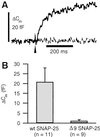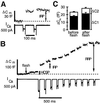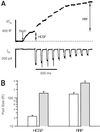A highly Ca2+-sensitive pool of vesicles is regulated by protein kinase C in adrenal chromaffin cells
- PMID: 12446844
- PMCID: PMC139269
- DOI: 10.1073/pnas.242624699
A highly Ca2+-sensitive pool of vesicles is regulated by protein kinase C in adrenal chromaffin cells
Abstract
We have used flash photolysis of caged Ca2+ and membrane capacitance measurements to probe exocytosis in chromaffin cells at low concentrations of intracellular Ca2+ ([Ca2+]i) (<10 microM). We observed a small pool of granules that is more sensitive to [Ca2+]i than the previously described "readily releasable pool." Upon activation of PKC, this "highly Ca2+-sensitive pool" is enhanced in size to a greater extent than the readily releasable pool but is eliminated upon expression of a C-terminal deletion mutant (Delta9) of synaptosome-associated protein of 25 kDa (SNAP-25). Thus, in chromaffin cells, PKC enhances exocytosis both by increasing the number of readily releasable vesicles and by shifting vesicles to a highly Ca2+-sensitive state, enabling exocytosis at sites relatively distant from Ca2+ channels.
Figures





Comment in
-
Specificity emerges in the dissection of diacylglycerol- and protein kinase C-mediated signalling pathways.Proc Natl Acad Sci U S A. 2002 Dec 24;99(26):16522-3. doi: 10.1073/pnas.022708199. Epub 2002 Dec 16. Proc Natl Acad Sci U S A. 2002. PMID: 12486246 Free PMC article. No abstract available.
Similar articles
-
Phosphomimetic mutation of Ser-187 of SNAP-25 increases both syntaxin binding and highly Ca2+-sensitive exocytosis.J Gen Physiol. 2007 Mar;129(3):233-44. doi: 10.1085/jgp.200609685. J Gen Physiol. 2007. PMID: 17325194 Free PMC article.
-
Protein kinase C-dependent phosphorylation of synaptosome-associated protein of 25 kDa at Ser187 potentiates vesicle recruitment.J Neurosci. 2002 Nov 1;22(21):9278-86. doi: 10.1523/JNEUROSCI.22-21-09278.2002. J Neurosci. 2002. PMID: 12417653 Free PMC article.
-
Protein kinase C enhances exocytosis from chromaffin cells by increasing the size of the readily releasable pool of secretory granules.Neuron. 1996 Jun;16(6):1209-20. doi: 10.1016/s0896-6273(00)80147-6. Neuron. 1996. PMID: 8663997
-
Calcium signaling and exocytosis in adrenal chromaffin cells.Physiol Rev. 2006 Oct;86(4):1093-131. doi: 10.1152/physrev.00039.2005. Physiol Rev. 2006. PMID: 17015485 Review.
-
Formation, stabilisation and fusion of the readily releasable pool of secretory vesicles.Pflugers Arch. 2004 Jul;448(4):347-62. doi: 10.1007/s00424-004-1247-8. Epub 2004 Mar 2. Pflugers Arch. 2004. PMID: 14997396 Review.
Cited by
-
Functional aspects and mechanisms of TRPV1 involvement in neurogenic inflammation that leads to thermal hyperalgesia.Pflugers Arch. 2005 Oct;451(1):151-9. doi: 10.1007/s00424-005-1423-5. Epub 2005 May 21. Pflugers Arch. 2005. PMID: 15909179 Review.
-
Effects of phorbol ester on vesicle dynamics as revealed by total internal reflection fluorescence microscopy.Pflugers Arch. 2008 Oct;457(1):211-22. doi: 10.1007/s00424-008-0485-6. Epub 2008 Mar 15. Pflugers Arch. 2008. PMID: 18343946
-
Phosphomimetic mutation of Ser-187 of SNAP-25 increases both syntaxin binding and highly Ca2+-sensitive exocytosis.J Gen Physiol. 2007 Mar;129(3):233-44. doi: 10.1085/jgp.200609685. J Gen Physiol. 2007. PMID: 17325194 Free PMC article.
-
Different effects on fast exocytosis induced by synaptotagmin 1 and 2 isoforms and abundance but not by phosphorylation.J Neurosci. 2006 Jan 11;26(2):632-43. doi: 10.1523/JNEUROSCI.2589-05.2006. J Neurosci. 2006. PMID: 16407561 Free PMC article.
-
Phosphorylation of SNAP-25 at Ser187 mediates enhancement of exocytosis by a phorbol ester in INS-1 cells.J Neurosci. 2008 Jan 2;28(1):21-30. doi: 10.1523/JNEUROSCI.2352-07.2008. J Neurosci. 2008. PMID: 18171919 Free PMC article.
References
Publication types
MeSH terms
Substances
Grants and funding
LinkOut - more resources
Full Text Sources
Miscellaneous

